The Tramways of Mexico City: Part 4 (original) (raw)
The Tramways of Mexico City (Ciudad de México)
BY
Allen Morrison
The Mexico City chapter is divided into four parts.Go to Part 1: Animals, steam and gasoline
Part 2: Early Electrics
Part 3: After the Revolution
Part 4: The STE in Color
In April 1946, amid strikes and disputes between the Canadian-controlled Mexico Tramways Company and its Mexican employees [see Part 3], the MTC - strangely, perhaps as an act of good faith - ordered a PCC tram from St. Louis Car Co. in the USA. PCC car 2000 arrived in Mexico City in January 1947 and was placed in express service on the Xochimilco line [see map]. The postcard view below shows "La Bella Rosa", as the vehicle was christened by passengers, before the Cathedral on Plaza de la Constitución [col. AM, gift of Claudio Bellon]:
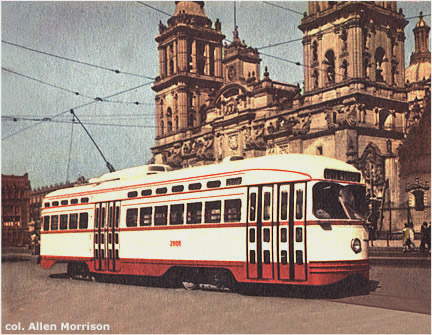
The Federal District's new Servicio de Transportes Eléctricos was organized in 1947, but did not completely take control of local transport until 1952. In 1947 STE ordered 20 Westram trolleybuses from the United States and operated two experimental trolleybus lines. (Commercial service began in 1951.) In 1947-1948 it purchased 116 trams secondhand from U.S. cities and closed the Aviación and Dolores tramway lines [see Part 3]. On 21 February 1953 Mexico City endured the worst transport accident in its history when trams 800 and 801 collided head-on on the suburban La Venta line [see map] [Associated Press]:
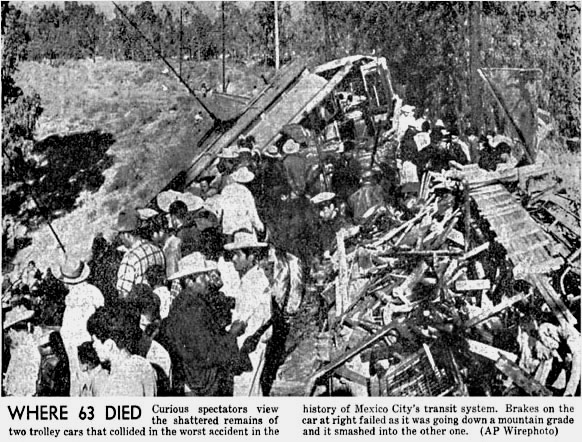
The disaster traumatized the nation and almost caused the complete closure of the capital's tramway system. The rolling stock was old and no longer adequate or safe. The La Venta line never reopened. STE also closed the Belén, Coyoacán, Ixtapalapa, Lerdo and Tizapán lines within months [see map]. On 17 August 1953 it placed in service a new car, number 680, which it had built at its Indianilla shops [Raymond DeGroote]:
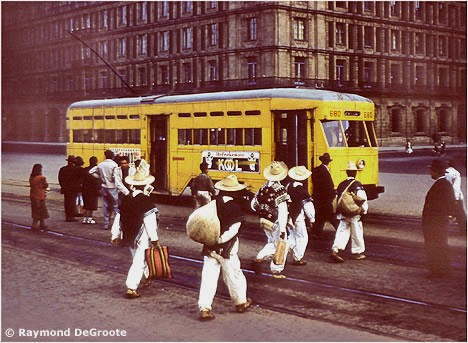
This was an obvious imitation of a PCC, but was not enough. In 1954 STE purchased 91 genuine PCC trams secondhand from Minneapolis and, in 1955, 183 more from Detroit. Because of their color the new trams were called "clorofilos" (chlorophylls) in Mexico City. The Minneapolis cars, numbered 2299-2439, began operation on the Obregón line on 24 March 1954 [see map]. Number 2388, below, was photographed in 1962 [col. www.tramway.com\]:
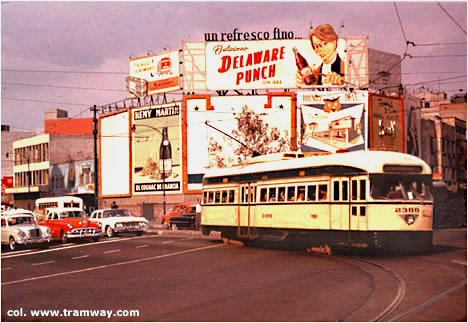
The Detroit vehicles, numbered 2102-2286, were virtually identical. In Mexico City two doors were cut on the left side of all PCCs for access from central platforms in the street. Detroit car 2156 was photographed in a new livery in 1978 [AM]:
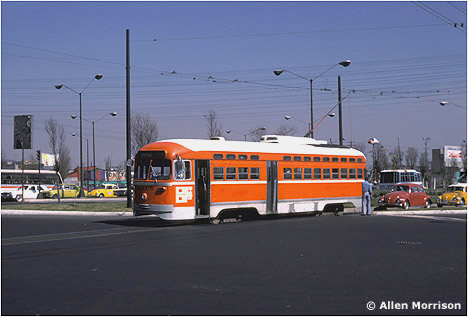
Some of the older trams were reconditioned and continued in operation. Here is a Mexico Tramways Co. reconstruction of a St. Louis Car Co. original of 1907. The picture was taken on the Xochimilco line [see map] in 1953 [William Janssen]:
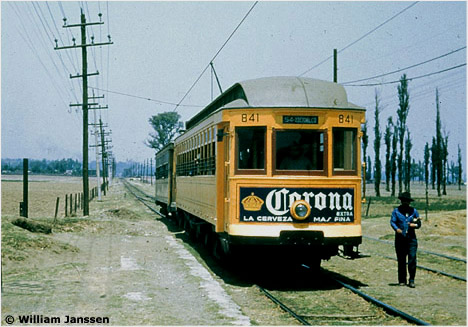
The extension of the Xochimilco line to San Gregorio (which continued to Tulyehualco until 1934 - see map and Part 3) was served by trams 891-895 in 1953. Note the catenary overhead [William Janssen]:
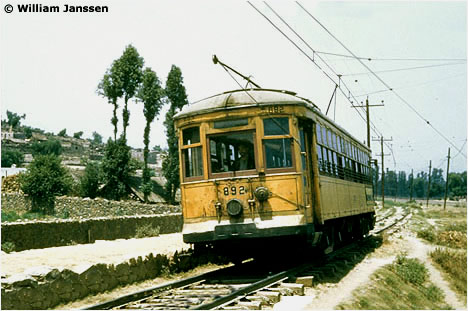
Here is another view of the San Gregorio line, which was part of a planned 162 km interurban line to Puebla [see Part 2]. The photograph was taken in 1954, shortly before the line closed [Ray DeGroote]:
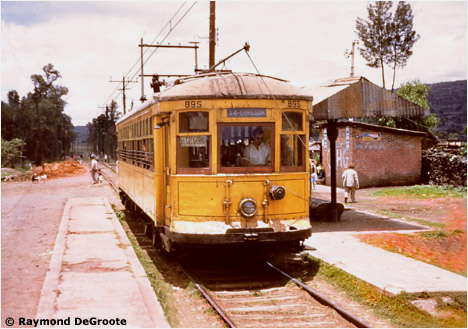
The Coyoacán line, which ran from Churubusco junction to Tizapán [see map], closed in 1953. Car 883 was photographed that year near Tizapán [J. W. Higgins]:
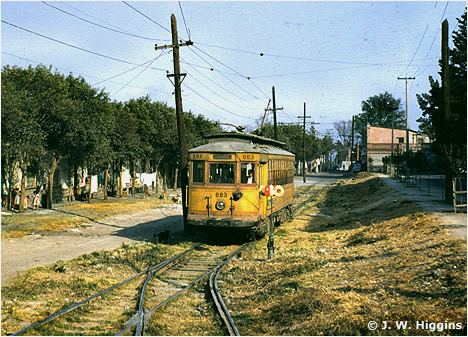
Tram 882, below, was of the same type but had had its clerestory removed. The same photographer caught this surreal scene on a newly paved thoroughfare in Villa Obregón [see map] [J. W. Higgins]:
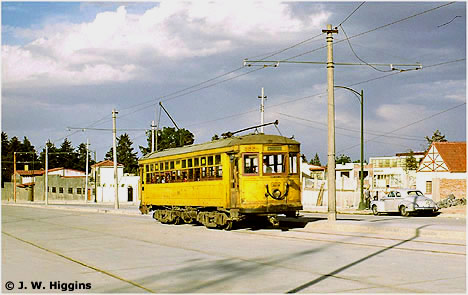
A few of the old yellow cars still ran in the center city. Here is number 270, built (or rebuilt) by the Canadian company in 1920, on the loop at the end of the Guerrero line [see map], in 1953 (J. W. Higgins]:
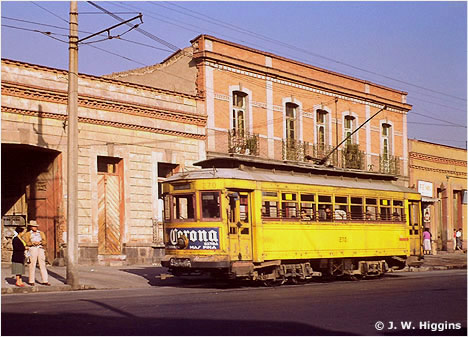
STE ran its last yellow streetcar in 1957 and abandoned the garages and shops at Indianilla, which had been built by Tranvías Eléctricos de México in 1898 [see Part 2]. A large new facility for its PCCs and trolleybuses opened at Tetepilco, 7.5 km south of the Zócalo [see map]. A small new depot was also erected at Azcapotzalco. A new tram route was constructed from Tetepilco across the lower part of the city to Mixcoac - replacing the crosstown Coyoacán line which had closed in 1953. In 1960 STE extended its Obregón line to the Universidad and double-tracked the Xochimilco route. The weekly pass below was good on all lines from 21 through 27 March 1961 [col. AM]:
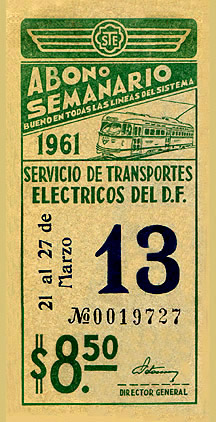
In 1967 a new organization, Sistema de Transportes Colectivos del Distrito Federal (STC), began construction of a rubber-tired metro. The first line, which opened in 1969, approximately duplicated the first horse tram route of 1858 and the first electric tram route of 1900 [see milestones map]. The second metro line, which opened along the Calzada de Tlalpan in 1970, replaced the northern section of the Xochimilco and Tlalpan tram lines, which thereafter were isolated from the rest of the tramway system [see area map]. PCC cars headed for the floating gardens of Xochimilco now left from Tasqueña metro terminal and were serviced at a small facility at Huipulco.
Government funds favored the new metro system and the tramway operation was neglected. The metro replaced more and more streetcar lines and tramway enthusiasts from around the world flocked to Mexico City to enjoy "the last days". Perhaps in appreciation, STE renovated tranvía cero (tram zero), one of the original Brill cars of 1899 [see Part 2], and inaugurated a circuito histórico along a portion of the Valle tram line in December 1971 [AM]:
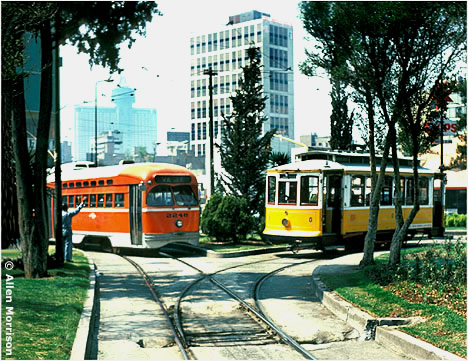
Car "0" started at Av. Cuauhtémoc, ran west along Av. Obregón, then south on Av. Insurgentes to the Glorieta Chilpancingo traffic circle - shown here - just below Av. Baja California [AM]:
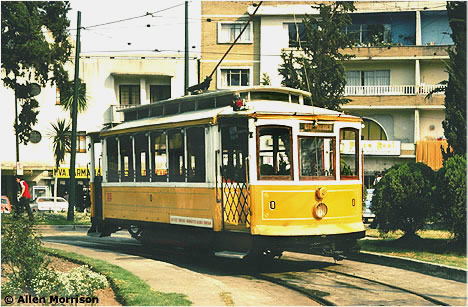
Abandonments continued and the last urban tram route - including the circuito histórico - closed in 1979. Tetepilco depot was henceforth used only by trolleybuses. The only tram services still operating in Mexico City were the two lines to Xochimilco and Tlalpan [see map]. Ex-Minneapolis PCC 2439 below, the highest numbered streetcar in the STE fleet, was photographed near Tlalpan terminus in 1982 [Foster M. Palmer]:
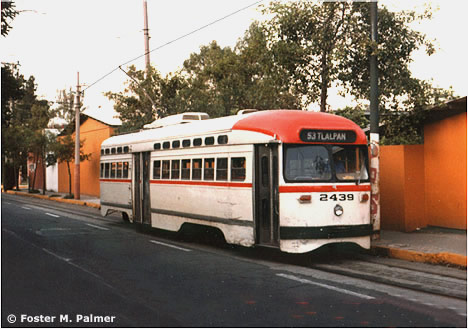
Car "0" ran again on the Tlalpan line in 1980, but both the Tlalpan and Xochimilco tramways shut completely in 1984. During the next two years no streetcars ran anywhere in Mexico City - or in Mexico.
A local firm, Motores y Adaptaciones Automotrices ("Moyada"), constructed 17 new 8-axle trams, numbered 000-016, from parts of PCCs. STE upgraded the tram line south of Tasqueña to "light rail" standards and restored tram service to Estadio Azteca, near Huipulco, in August 1986 [see map]. Rail service returned to Xochimilco in 1988 and to Tlalpan in 1990, where Moyada 001 was photographed that year [Steve J. Morgan]:
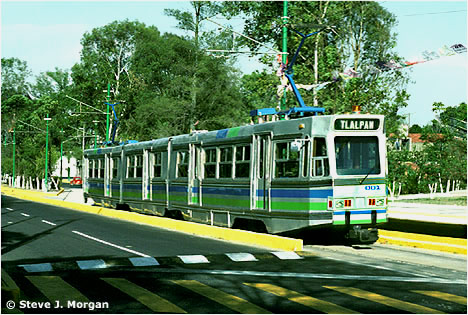
Historic car "0" also returned briefly to the Tlalpan line in 1990. The following year a dozen completely new 6-axle trams, built by Concarril in Mexico and numbered 017-028, replaced the Moyadas on the Xochimilco line. The Tlalpan branch remained intact but out of service. Here is 025 near Huipulco in 1995 [Thomas E. Fischer, col. www.tramway.com\]:
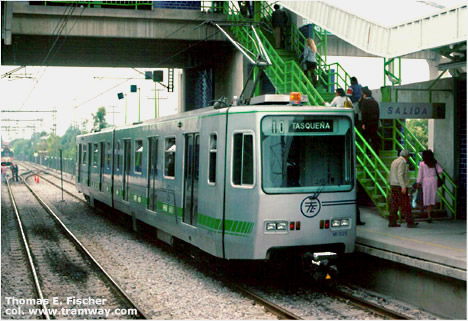
In the 21st century, at least a small part of Mexico City's tramway system survives, almost 150 years after it began [see Part 1]. Trams no longer run to Tacubaya, but trolleybuses do and STE's Tren Ligero to Xochimilco thrives. One of the dozen metro lines uses overhead wire and steel wheels - instead of third rail and rubber tires. Because of the surrounding mountains, air pollution is a huge problem. Who knows what the future holds?
In addition to the photographers noted above and the following articles, books and maps, the author is indebted to Héctor Lara Hernández and Luis León Torrealba of Mexico City for their invaluable assistance in this survey. Thanks are also due Harold E. Cox of Pennsylvania for information about tram car orders. There are still many mysteries about the development of tramways in the Mexican capital, but without their generosity the missing links would be more.
BIBLIOGRAPHY **(in order of publication)**Arthur J. Lonto. "Mexico City Today" in ERA Headlights (Hoboken, NJ), 11/1961, pp. 1, 5-7. Short article with large map and six photos (including on cover).
Glen D. Bottoms & Luis León Torrealba. "Mexico, D.F. Where Tramlines Are Still Being Built" in _ERA Headlights (Hoboken, NJ),_7/1974, pp, 1-7. Nice article with 2-page map (showing tram and metro lines) and 13 excellent photographs.
Martin Jenkins. "The Tramways of Mexico. Part 1: Mexico City" in Modern Tramway (London), 7/1974, pp. 232-241. A major survey with map (showing tram, trolleybus, metro and railroad lines), charts and six photographs. Excellent detail on route development (and closures) and the car fleet.
Brian Edwards. "Mexico City's PCCs" in Timepoints (Los Angeles), 9/1984, pp. 1, 3-7. Description and nine superb, large photos of the trams in their last days.
Héctor Lara Hernández. "El Servicio de Transportes Eléctricos del D.F." in Servicio de Transportes Eléctricos del D.F.: Apuntes Históricos. México, 1/1992, 3 pages. Nice essay on the origin and development of the STE.
Héctor Lara Hernández. "El Tranvía Cero" in Servicio de Transportes Eléctricos del D.F.: Apuntes Históricos. México, 2/1992, 2 pages. The definitive article on the famous preserved Brill tram.
Gabriel Esparza Velázquez, ed. Los 101 Años del Transporte Eléctrico en la ciudad de México. México, 2001.
Joel Álvarez de la Borda, Javier Lazarín Guillén & David Luvín Guzmán Pérez. Ciento un años de Transporte Eléctrico en la Ciudad de México. Index page of the Internet version of the printed text above: 12 chapters, dozens of pages, maps, photographs and other illustrations.
Manuel Aguirre Botello. Los Tranvías de la Ciudad de México, 1850-1971. This wonderful website provides a complete survey of tramway development in Mexico City. The map of the Rutas de Tranvía de la Ciudad de México, 1930-1950 is an extraordinary document. Pass the cursor over a route name on the list and the route lights up!
Allen Morrison. Streetcars in Mexico City in the 1950s. A 10-minute YouTube video made from 16mm films shot by Gene Schmidt in 1953 and 1958.
Go to Part 1: Animals, steam and gasoline
Part 2: Early Electrics
Part 3: After the Revolution
Return to INTRODUCTION & INDEX MAP